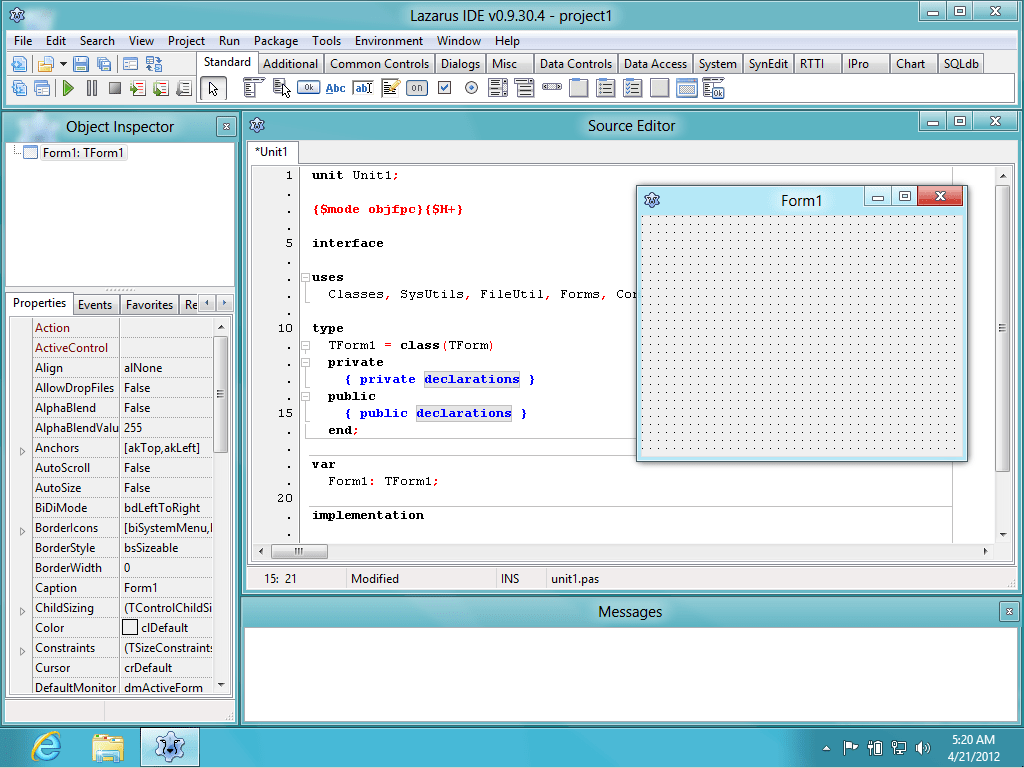About Lazarus Project
Lazarus was started in February of 1999. It was primarily founded by three individuals:
- Cliff Baeseman
- Shane Miller
- Michael A. Hess
All three had attempted to get involved with the Megido project which dissolved. In frustration they started the Lazarus project. It has had a steady growth of supporters and developers during the following years. The founders are not involved with the project any more.
The next oldest member of the team is Marc Weustink. He got involved with the project in Aug. 1999. Following him is Mattias Gaertner who got involved in Sept. 2000. Both of them have been the major contributors to the core of what makes Lazarus tick. More about the history in the Wiki
So just what is Lazarus?
Lazarus is a Delphi compatible cross-platform IDE for Free Pascal. It includes LCL which is more or less compatible with Delphi’s VCL. Free Pascal is a GPL’ed compiler that runs on Linux, Windows, macOS, FreeBSD and others. Free Pascal is designed to be able to understand and compile Delphi syntax, which is OOP. Lazarus is the part of the missing puzzle that will allow you to develop Delphi like programs in all of the above platforms. Unlike Java which strives to be a write once run anywhere, Lazarus and Free Pascal strives for write once compile anywhere. Since the exact same compiler is available on all of the above platforms it means you don’t need to do any recoding to produce identical products for different platforms.
Yeah, but what about the GUI? What widget set are you using?
That is the neat part. You decide. Lazarus is being developed to be totally and completely API independent. Once you write your code you just link it against the API widget set of your choice. If you want to use GTK+, great! If you want it to be Gnome compliant, great! As long as the interface code for the widget set you want to use is available you can link to it. If it isn’t available, well you can write it.
For example. Let’s say you are creating a product on Windows using the standard Windows widgets. Now you want to create a Linux version. First you decide what widget set you want to use. Let’s assume you want to use gtk+. So you copy the code over to your Linux development machine, compile, and link against the gtk+ interface unit. That’s it. You’ve now just created a Linux version of the Windows product without any additional coding.
At this point in the development we are using Win32, gtk2+, Carbon, Cocoa and QT as our API widget set. Bindings for custom drawn components are in the works and other widget sets are planned, too.
So is this thing really RAD like Delphi?
It sure is. Is it totally completed? No not yet.The overall IDE is complete and can be used for most programming needs. Several aspects of the project are still in need of help. Hint. Hint.
Can I use my existing Delphi code?
Some of it yes. If the code is standard Delphi pascal and it uses the standard components found in Delphi then the answer is yes. If it uses some specific database, OCX, or DCU then the answer would be no. These items are specific to Windows and would only work on and within Windows. However, if you are only looking to create a Windows product using Free Pascal and Lazarus then the answer would be yes. This hasn’t been added to the LCL yet but it should be possible in the future.
Can I create commercial products with this?
Yes. The code for the Free Pascal compiler is licensed under the GPL. This means that it is open source, free, whatever name you want to stick to it. You can modify the code if you wish but you MUST distribute those changes or make them available to others if they wish to use it.
The FCL (Free Pascal Component Libraries) and the LCL (which will eventually become part of the FCL) are licensed under a modified LGPL. In a nut shell this means that you can write your own proprietary software that just links to these libraries. You can sell your application without the need to supply or make available your code. However, as with the compiler if you make modifications to the FCL or LCL you must make those changes available to the general public and the world.
I give up, where did the name come from?
One of the original projects that made an attempt to build a Delphi clone was Megido. However this effort died. Lazarus as you know was the biblical figure that was raised from the dead by Christ. Soooooo. The project is named Lazarus as it was started/raised from the death of Megido.
© 1993-2022 Lazarus and Free Pascal Team
Features
[1] LGPL with additional permission to link libraries into your binaries.
[2] Some additional packages come with various licenses such as GPL, MPL, .
[3] Linux/BSD applications may depend on GTK2 or alternatively QT.
Cross Platform
Lazarus runs on Windows, macOS, Linux and many other platforms. Even on Raspberry Pi! The programs you create also runs on these platforms. Enjoy the same experience on your favorite OS. See Installing Lazarus for OS-specific instructions for installation.
Powerful, Fast
Lazarus is a capable IDE for handling large projects. Its compiler FPC is being constantly developed to improve performance. As an example for the project size the IDE can handle, and the performance of the resulting application: The Lazarus IDE itself is developed using Lazarus.
Drag and Drop Form Designer
Lazarus has a graphical form designer with guidelines for aligning with adjacent components. There are numerous components for almost every software imaginable, already ready to be used. Further components can be added to the IDE by Lazarus Package Files (LPKs).
Cross-platform
Lazarus form designer uses LCL (Lazarus Component Library) which is especially designed for cross platform usage. Building your project for different platforms will give you native look and feel on each platform. There are no changes to the project needed.
Modern, Object oriented language
Lazarus uses Free Pascal as its language which is an Object Pascal dialect. It is constantly developed to integrate new features that can be expected in modern programming languages.
Easily Extendable
Hundreds of developers are developing and maintaining their Lazarus Libraries and Lazarus Packages (LPKs). You can find almost any kind of library that you may need.
Open source
Lazarus is open source and the core libraries [4] are distributed under LGPL with the extra permission of static linking. So you can create non-commercial and commercial applications with it.
[4] This applies to LCL, FCL, RTL. It covers all the standard components and many other. Some of the packages with extra components may be GPL, MPL or other
Frameworks
Various Frameworks are available which saves your time on certain codebase.
Here is a version-based feature history which has animations to show you many features in action: Wiki: New IDE features since
© 1993-2022 Lazarus and Free Pascal Team
Приветствуем на сайте Lazarus IDE
Lazarus — это специальная программа с интегрированной (свободной) средой для разработки на основе компилятора Free Pascal. Lazarus — программа с полностью открытым исходным кодом, которая направлена на обеспечение библиотек класса Free Pascal . FP — компилятор интегрированной среды разработки соответствует образцу программе Borland — Delphi — и библиотеки Лазарус, которые эквивалентны VCL. Она смоделирована на Delphi и позволяет импортировать проекты, выполненные в Delphi.

Основные Возможности
- Работает на многих платформах
- Открытый исходный код для создания любых проектов
- Возможность использовать 200 компонентов
- Внедрении необходимых компонентов через пакет файлов
- Возможность использовать программу для коммерческих целей
Окружающая среда Lazarus подходит для всех разработчиков и особенно для тех, кто намерен создавать программы с нуля. Интерфейс программы очень прост, как для новичков, так и для тех кто уже занимается программированием на профессиональном уровне. Этого удалось достичь принципом перетаскивания выбранного компонента. Программа позволяет создавать приложения с помощью перетаскивания всех необходимых элементов и помещать их в специальные окна. Большим преимуществом этой программы является возможность компиляции для любых операционных систем (Windows, OSX, Linux и Windows CE).
Очередным преимуществом программы является быстрый переход между различными интерфейсами и системами обеспечения библиотеки интерфейса. На данный момент, Lazarus поддерживается следующими типами интерфейсов: WIN32 GDI, GTK + 1.2.x (Unix, Mac OS X), GTK + 2.x, Qt 4 (C ++) и Windows. К тому же, Лазарус является одним из немногих инструментов, в отличии от своих конкурентов, который может создавать приложения для ПК (Windows CE, Qtopia).

Особенностью приложения является полностью самостоятельное API, как только вы напишите свой собственный код, вы можете просто подключить его с помощью API. Возможности проекта, например:
Если вы создаете продукт на Windows, используя стандартные виджеты Windows, сначала нужно определится какой набор виджетов вы хотите использовать. Затем скопируйте код на ваше устройство Linux разработки, компиляции и ссылки с GTK + интерфейсного блока. Вот и все — вы только что создали версию вашего продукта для Linux на Windows с помощью Lazarus без какого-либо дополнительного кодирования.
Пример работы с Лазарус
Для тех, кто работает с кросс-платформами, Лазарус — это удивительный проект, который обещает сделать создание виджетов намного проще.
Лазарус — отличный, бесплатный компилятор который подойдет для ежедневного использования, как новичкам, так и продвинутым пользователям, благодаря удобно расположенным кнопкам и интуитивно понятному интерфейсу вы уже с первого дня сможете начать разработку своего приложения.
Со временем автора намерены добавить полную поддержку PalmOS и Symbian OS. Программа доступна как на русском так и на украинском языке.
Уроки программирования
Как говорится лучше один раз увидит чем 100 раз услышать. Лазарус это отличная программа с помощью, которой вы сможете создавать полезные и функциональные приложения и качественные проекты. Изучение Лазарус не займет у вас много времени, но все же мы настоятельно рекомендуем вам заняться изучением этой программы с помощью видео уроков, где вы начнете с самых азов и спустя некоторое время самостоятельно сможете создавать свои собственные приложения. У нас на сайте есть отличная рубрика видео уроков в которой мы приготовили для вас только лучшие и практичные уроки по работе с Лазарус. Для начала предлагаем вам первый видео урок ознакомления и обзора данной программы.
Версия Лазарус
На сегодняшний день актуальная версия 2.2.0. Следующее обновление будет под версией 2.4.0. В этом обновлении вас ожидает значительное улучшение и модернизирование программы, а так же перевод Лазарус на многие языки.
Немножко истории
Проект стартовал в феврале 1999 г. Основателями были три частных лица:
- Клифф Baeseman
- Шейн Миллер
- Майкл А. Гесс
Все трое пытались создать проект Megido, который в итоге не осуществился. В отчаянии они начали проект Lazarus. На сегодня этот проект имеет постоянный рост благодаря участию сторонних разработчиков. Сами же создатели уже не участвуют в проекте.
Скачать последнюю версию
Скачать последнюю версию Lazarus IDE вы можете в специальном разделе на нашем сайте.
При подготовке материала использовались источники:
https://www.lazarus-ide.org/index.php?page=about
https://www.lazarus-ide.org/index.php?page=features
https://lazarus-rus.ru/
 Онлайн Радио 24
Онлайн Радио 24